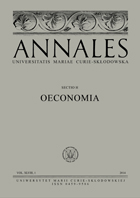Analiza wskaźnika F-Score dla spółek giełdowych z branż IT i gier wideo
Analysis of the F-Score Indicator for Listed Companies from the IT and Video Games Industries
Author(s): Bartłomiej PilchSubject(s): Economy, Business Economy / Management, Financial Markets, ICT Information and Communications Technologies
Published by: Wydawnictwo Naukowe Uniwersytetu Marii Curie-Sklodowskiej
Keywords: wskaźnik F-Score; skoring; stopy zwrotu; branża gier; branża IT;F-Score indicator; scoring; rates of return; video game industry; IT industry
Summary/Abstract: Uzasadnienie teoretyczne: F-Score jest modelem opartym na metodzie skoringowej. Jego wysokie wartości wskazują na solidne fundamenty finansowe danej spółki oraz w uproszczony sposób pozwalają wyróżnić jednostki atrakcyjne pod kątem wyboru do portfela inwestycyjnego. Od czasu opublikowania pierwotnej wersji tego modelu przez Piotroskiego w 2000 roku przeprowadzono wiele badań weryfikujących jego skuteczność na różnych rynkach. W znakomitej większości przypadków ich wyniki wskazały na celowość stosowania tego modelu. Nieczęsto jednak brano w tym kontekście pod uwagę polską giełdę papierów wartościowych, w związku z czym wydaje się, że badanie takie może dostarczyć cennych informacji dla polskich inwestorów.Cel artykułu: Główną przesłanką podjęcia badań w zakresie oceny skuteczności modelu F-Score było istnienie niewielkiej liczby opracowań, które skupiają się na polskim rynku giełdowym w tym zakresie. Poza tym specyficzny dobór spółek reprezentujących dwie branże, na jaki się zdecydowano, może istotnie wpłynąć na wyniki takiego badania, dostarczając także informacji o skuteczności modelu F-Score w odniesieniu do wybranych sektorów gospodarczych. Wobec tego celem badania uczyniono weryfikację efektywności działania wskaźnika F-Score na przykładzie przedsiębiorstw z branży IT i gier wideo notowanych na Giełdzie Papierów Wartościowych w Warszawie (GPW).Metody badawcze: Głównymi metodami, jakimi posłużono się w ramach niniejszej analizy, są statystyki opisowe (średnia arytmetyczna, mediana, odchylenie standardowe, współczynnik zmienności). Użyto ich w celu analizy zróżnicowania wartości F-Score zarówno pomiędzy branżami, jak i w czasie, a także pod kątem oceny skuteczności tytułowego modelu (w postaci porównania stóp zwrotu z danymi finansowymi za rok poprzedni). Badanie przeprowadzono na podstawie danych finansowych spółek notowanych na Głównym Rynku GPW i NewConnect z branż gier wideo i IT. Analizą objęto okres 2017–2019.Główne wnioski: Na podstawie przeprowadzonego badania wysunięto następujące wnioski: 1) występuje zróżnicowanie wartości F-Score zarówno pomiędzy branżami gier wideo a IT, jak i w czasie; 2) wyższe wartości wskaźnika B/M nie wpływały na wyższe stopy zwrotu z akcji w kolejnym roku; 3) wyższe wartości modelu F-Score wpływały na wyższe przeciętne stopy zwrotu z akcji w kolejnym roku. Tym samym na podstawie spółek notowanych na GPW potwierdzono skuteczność modelu F-Score. Wskazano również na konieczność uwzględnienia zróżnicowania pod względem branż. Wnioski te mogą być użyteczne w procesie decyzyjnym dla inwestorów – spółki o wysokich wartościach F-Score jawią się jako atrakcyjne pod względem inwestycyjnym, mogące przynieść potencjalne zyski przewyższające benchmark.Theoretical background: The F-Score is a model based on the scoring method. Its high values indicate solid financial foundations of a given company, and in a simplified way they make it possible to distinguish units that are attractive in terms of selection for the investment portfolio. Since the publication of the original version of this model by Piotroski in 2000, many studies have been carried out to verify its effectiveness in various markets. In the vast majority of cases, their results indicated the advisability of using this model. However, the Polish stock exchange was not often taken into account in this context, therefore, it seems that such a study may provide valuable information for Polish investors.Purpose of the article: The main premise for undertaking research on the assessment of the effectiveness of the F-Score model was the existence of a small number of studies focusing on the Polish stock market in this area. In addition, the specific selection of companies representing two industries may significantly affect the results of such a study, also providing information about the effectiveness of the F-Score model in relation to selected economic sectors. Therefore, the aim of the study is to verify the effectiveness of the F-Score indicator on the example of companies from the IT and video game industries listed on the Warsaw Stock Exchange (WSE).Research methods: The main methods used in this analysis are descriptive statistics (arithmetic mean, median, standard deviation, coefficient of variation). They were used to analyze the differentiation of the F-Score values, both between sectors and over time, as well as to assess the effectiveness of the title model (in the form of a comparison of rates of return with financial data for the previous year). The research was based on the financial data of companies listed on the WSE Main Market and NewConnect from the video games and IT industries. The analysis covered the period 2017–2019.Main findings: Based on the study, the following conclusions were drawn: 1) there is a differentiation of the F-Score values both between the video game and IT industries, and also over time; 2) higher values of the B/M ratio did not affect the higher rates of return on shares in the following year; 3) higher values of the F-Score model influenced higher average rates of return on shares in the following year. Thus, the effectiveness of the F-Score model was confirmed on the basis of companies listed on the WSE. It also indicated the need to take into account the differentiation in terms of industries. These conclusions can be useful in the decision-making process for investors – companies with high F-Score values appear attractive in terms of investments, which can bring potential profits exceeding the benchmark.
Journal: Annales Universitatis Mariae Curie-Skłodowska, Sectio H Oeconomia
- Issue Year: LV/2021
- Issue No: 1
- Page Range: 41-50
- Page Count: 9
- Language: Polish

